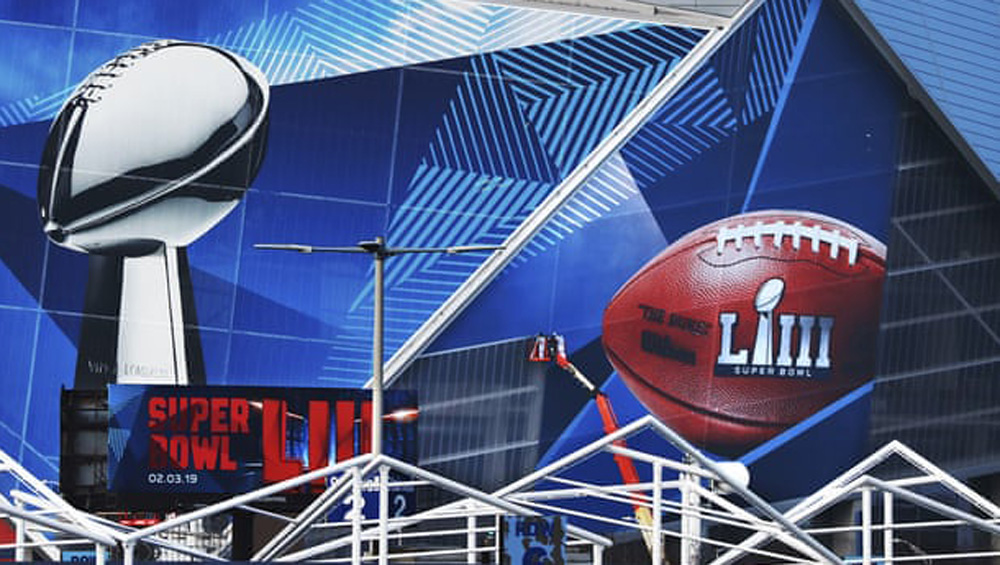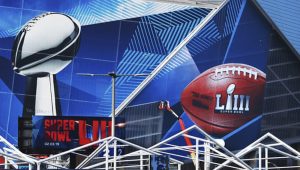
CBS Pumps Up Super Bowl Tech With 8K, AR

 For its 20th Super Bowl broadcast on Feb. 3 (the most of any network), CBS hopes to take coverage to a new level by becoming the first U.S. network to use multiple 8K ultra-high-definition cameras in a live sports broadcast.
For its 20th Super Bowl broadcast on Feb. 3 (the most of any network), CBS hopes to take coverage to a new level by becoming the first U.S. network to use multiple 8K ultra-high-definition cameras in a live sports broadcast.
The Panasonic 8K units, which will be used to generate replays from each end zone, are just two of the 115 cameras that CBS will use to cover the game at Mercedes-Benz Stadium in Atlanta.
They will be complemented by a bevy of 4K replay cameras and specialty cameras with augmented reality graphics capability.
CBS will also be streaming Super Bowl LIII on its subscription OTT service, CBS All Access, for the first time, and the game will also be available on other direct-to-consumer platforms as well as mobile devices. But CBS President and Acting CEO Joe Ianniello says CBS’s focus remains on delivering a high-quality broadcast product.
“We are on more platforms than ever before,” he says. “But at the center of that is broadcast television, the biggest, best and most reliable way to deliver to a mass audience.”
Like several other major networks, for the past few years CBS has boosted its replay capabilities with Sony 4K high-frame-rate cameras. The Sony cameras, in particular the HDC-4800 unit, enable super-slo-mo replays from more traditional game camera positions. They also include “HD cutout” capability that effectively lets an operator zoom in on part of the 4K image for a closer look while maintaining image clarity for HD viewers at home.
For the Super Bowl, CBS is upping the ante by mounting two Panasonic 8K cameras high up in the stadium’s rafters to provide a wide, overhead view looking down at the end zones.
Operators can use the 8K units to zoom in to capture crisp replays of pivotal plays along the goal lines and end lines, even out to the 10-yard line. Of the various technical innovations CBS is bringing to the production, 8K is perhaps the most exciting, says CBS Sports Chairman and Super Bowl LIII executive producer Sean McManus.
“The clarity of the 8K cameras will probably have the most immediate impact, to not lose resolution during replays,” says McManus.
CBS began talking to Panasonic six months ago about using the 8K cameras, “but we didn’t find out until the second week in December that they would be able to pull it off,” says Ken Aagaard, EVP of innovation and new technology for CBS Sports, who will be working on his 19th Super Bowl.
While the file sizes of 8K replays are substantially larger than 4K replays (8K is twice the vertical and horizontal resolution of 4K), Aagaard says an 8K replay can be turned around in a workable timeframe “if you have the right operator.”
CBS does “cut-outs” of the pictures from its 4K cameras to generate replays, and Aagaard says it will take a similar approach with the 8K units.
While the general rule of thumb is taking one-quarter of a 4K picture for a 1080i HD replay, Aagaard says there isn’t a set fraction that CBS will use when working with 8K and that production staff will be experimenting onsite before the game. Light levels will be critical.
“You don’t look at it dimensionally, you go as deep into it as you can,” he says. “I don’t know what the limitations will be yet.”
The 8K cameras will be supplemented by 16 4K cameras including nine Sony HDC-4800 and seven HDC-4300 spread around the stadium. The 4K cameras will be in more locations than usual, including carts, reverse-sideline carts and slash-camera positions.
Aagaard notes that a key replay of Carolina Panther QB Cam Newton fumbling in Super Bowl L was captured by a reverse-sideline cart 4K camera, the only angle CBS had of the play.
“With the number of 4K cameras we have for replays we’ll be able to look from every angle,” says Aagaard. “We’re not going to miss anything.”
In that vein, CBS will surround each end zone with over 25 cameras. They include six 4K cameras, two standard HD super-slo-mos and three “goal-post” super-slo-mos shooting the end line. There will also be “Pylon Cam” units, each of which includes four cameras, mounted on each corner of the end zone. Typically, CBS typically only employs “Pylon Cam” on the front corners of the end zone.
To better explain the game action, CBS will use several cameras which incorporate augmented reality graphics. They include three “SkyCam” aerial cable camera systems, which use Sports Media Technology player-tracking graphics to telestrate plays like pass routes and also can insert AR graphics of statistics or logos on the field.
One SkyCam will be in the usual high position and another in a low position while a third SkyCam will be used as a “peek-a-boo” camera to hover over the CBS set.
Aagaard says that CBS analyst Tony Romo, who will be calling the game with veteran play-by-play man Jim Nantz, is fond of using the high “All-22” SkyCam position with graphic overlay to explain pass plays.
For the first time, CBS will also use a live wireless handheld camera with AR graphics and camera-tracking capability. It is designed to provide real-time virtual graphics from the players’ perspective on the field. This two-operator system will probably be located on the sideline in a low position in order to give a field-level view of AR graphics, and may be used to show a graphic like a quarterback’s stats before the snap.
“I’ve seen augmented reality off the SkyCam, and off of goal post cameras, and I said what can we do with a Steadicam on the field?” says lead director Mike Arnold, who will be directing his fifth Super Bowl.
The handheld AR camera system, which CBS calls “Wireless Outdoor Marker-Less Camera Tracking,” was developed in partnership with technology vendors Aerial Video Systems (AVS), Ncam and The Future Group. It marries AVS’ RF technology with NCam’s camera-tracking hardware and software and The Future Group’s graphics engine.
The two-operator system starts with a Sony HDC-P1 camera within a Steadicam rig, with a conventional AVS RF transmitter sending video back to a Ncam system.
In addition, the Steadicam operator is tethered to a Ncam operator outfitted with a backpack containing an external battery, a computer generating tracking data, keyboard, monitor and a second AVS transmitter that is sending tracking data back to the Ncam computers as well. The physical tether between the camera and the Ncam operator’s backpack contains both a BNC cable for camera reference and a CAT-5 cable for the lens tracking data.
The video and data get married at the Ncam system, explains Aagaard, before being sent to The Future Group’s graphics engine to generate live trackable graphics.
CBS will bring back EyeVision, the 360-degree replay camera technology it introduced in 2001 and which is now owned by Intel and installed in several NFL venues, including Atlanta.
The network also plans to use a 360-degree camera system from vendor C360 Technologies that will be hung from a cable mounted in the center of the Mercedes Benz Stadium roof. The C360 camera will be able to move up and down in the vertical plane, via a simple pulley system, and provide a bird’s eye perspective of both the crowd and 63,000-square-foot HD video screen that circles the opening in the stadium’s roof.
“It’s a very effective shot,” says Aagaard.
NEP’s SSCBS mobile production unit will be the flagship truck for CBS, with key gear including Evertz IP routing, a Grass Valley Kayenne K-Frame production switcher, Calrec Apollo audio console and EVS replay systems.
SSCBS will supported by additional units from NEP, Game Creek Video and F&F Productions. F&F’s GTX 17 will be the tape-release truck (handling recording functions) while Game Creek will supply the edit trucks supporting highlights, teases and the seven hours of pregame coverage.
Although the Super Bowl is the biggest sporting event of the year, Arnold says he tries to direct it like a regular-season game. With more than 100 cameras at his disposal, he still relies mostly on “my 20 core cameras” although there are perhaps 15 more cameras he will consider for a live shot. He notes most of the additional cameras are dedicated to replays.
“With 115 cameras, these guys have got a lot of places to go to,” says Aagaard. “It gets down to the selection process. The 8K will be the icing on the cake.”
Editor’s note: This story has been updated to clarify that the 8K cameras are from Panasonic.
































Comments (0)